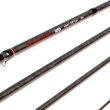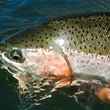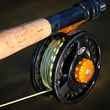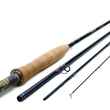It has been a while since I've suffered the displeasure of stinky waders. This is most likely because I don't get on the water as much as I'd like to these days, or that I've been finding a way to destroy my waders before I've owned them long enough to build up an odor. The reality for most of us, however, is that after a while waders begin to turn rank.
Earlier this year, upon boarding a Dehavilland Beaver -- cozy quarters for a five man float plane ride to a preposterously fishy salmon stream in the Tongass National Forest -- myself and the rest of the group I was fishing with received a rank waders warning from our guide for the day. As the doors closed and the cabin air immediately began to feel stagnant, we were warned of the impending doom. "Imagine that a wet sheep fell out of the sky and landed on an unsuspecting cat, who was was happily snacking on dead pink salmon. As a result, the cat pissed itself to death. The pair lay in a pile. Now imagine all this happened several weeks ago. Right here," as he motioned to his mid and lower torso area. The reality didn't turn out to be quite that bad, but at least we were prepared.
The culprit behind the malodorous stench that well-worn waders emit is bacteria. Even the best breathable waders eventually start to stink. And the reality is that the types of bacteria that can thrive in the warm, often moist environment inside your waders can do more damage than simply stinking up the place, they can cause some nasty infections. I've spoken with and read about many anglers that ended up with serious infections as a result of having worn bacteria-filled waders. The typical circumstances involve anglers donning their waders while having small, pre-existing cuts or abrasions on their legs or -- more commonly -- having fallen while wearing their waders and, despite the fact that the waders didn't puncture or tear, have broken the skin inside the waders. In these scenarios, bacteria living inside the waders are given an opportunity to enter the bloodstream.
The most common "wader-borne" infection is known as a staph infection, caused by the bacteria Staphylococcus aureus. Staph infections can range from mild and easily resolved to serious and even fatal. This includes the highly publicized MRSA (pronounced mer-sah), which refers to Methicillin-resistant Staphylococcus aureus, a form of staph that has evolved to become resistant to antibiotics commonly used to treat staph infections. Staphylococcus aureus is commonly found in the environment, including on the human body. But waders can be a environment for Staphylococcus aureus to rapidly grow and multiply, given that staph thrives in warm, moist environments.
And we all know what warm, moist environments waders can be. I can't imagine there is an angler out there that hasn't found him or herself checking their waders for leaks after taking them off and the end of the day and discovering soaked pants and socks. Of course, that leak most often doesn't turn up, you've just soaked your clothes with sweat.
The idea here isn't to be afraid of your waders. Most healthy individuals with robust immune systems will resist staph infections quite well. The reality, however, is that the environment inside your waders is a place for Staphylococcus aureus to thrive and increase your chances of infection. And let's not forget where we started -- even if your waders aren't making you ill, they're likely stinking up the joint and making everyone who has to ride to the river with you a little green.
The solution to both of these issues is proper wader maintenance. In other words, cleaning. If you've ever spent an afternoon scrubbing the outside of your waders, waiting for them to dry in the sun, and then repeating the process on the inside of your waders, you know what a pain the process can be. But you really should be doing it. Not only will it keep your waders clean and odor free, it will prolong their life. Thankfully, there may be an easier way. Enter Clear Gear.

Clear Gear is a sports spray that, like Staphylococcus aureus, is rapidly multiplying in the sports world. Clear Gear has been showing up in places ranging from the locker room at the local gymnasium to that of the NFL's New York Giants. Typically, Clear Gear is used to fight bacteria on shared equipment such as pads, helmets, mats and so on. But, as it turns out, Clear Gear is also well suited to cleaning, disinfecting and de-odorizing your disgusting waders. And, it's proven to kill Staphylococcus aureus (including MRSA), flesh-eating bacteria, athlete's foot and a bunch of other nasty stuff you wouldn't expect to find in your waders like SARS, RSV, Herpes and more.
I've been using Clear Gear for the last few months to try to keep my currently un-stinky waders just so, and so far so good. There's not much to it. Turn your waders inside out, spray all surfaces thoroughly, let them dry, right-side them out, repeat. It's a hell of a lot easier than the scrub brush and soap method, is most likely decidedly more effective, and -- because it is relatively easy -- is something I'll actually make my self do periodically instead of putting it off and ultimately neglecting it entirely.
There's one more detail that our crack team of researchers (me) has tried -- unsuccessfully -- to verify: Clear Gear might kill whirling disease. If you're not familiar with whirling disease, you should be. According to the Montana Water Center, "Whirling disease affects fish in the trout and salmon family. By damaging cartilage, whirling disease can kill young fish directly, or cause infected fish to swim in an uncontrolled whirling motion. This can make it impossible for them to escape predators or to effectively seek food. The whirling disease parasite has been found in wild fish and fish hatcheries in 25 states. Once established in a stream, the parasite cannot be eradicated, nor can its worm host, without significantly damaging the ecosystem."
One of the most important ways to stop the spread of whirling disease is by cleaning equipment to help prevent transport of the parasite from an infected water body to one that is not. As it turns out, one of the few known killers of the parasite that causes whirling disease are quaternary ammonium compounds. One of Clear Gear's active ingredients is Didecyldimethylammonium chloride, an antiseptic and quaternary ammonium compound. We're (I am) still working to determine if Didecyldimethylammonium chloride is in fact a known eradicator of the whirling disease parasite. If it turns out to be, then add one more big reason to add Clear Gear to your angling arsenal.






























Comments